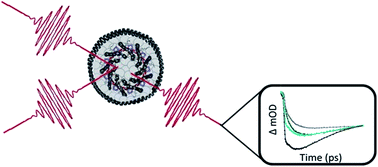当前位置:
X-MOL 学术
›
Chem. Sci.
›
论文详情
Our official English website, www.x-mol.net, welcomes your feedback! (Note: you will need to create a separate account there.)
Impact of the lipid bilayer on energy transfer kinetics in the photosynthetic protein LH2†
Chemical Science ( IF 8.4 ) Pub Date : 2018-02-09 00:00:00 , DOI: 10.1039/c7sc04814a John I Ogren 1 , Ashley L Tong 1 , Samuel C Gordon 1 , Aurélia Chenu 1 , Yue Lu 2 , Robert E Blankenship 2 , Jianshu Cao 1 , Gabriela S Schlau-Cohen 1
Chemical Science ( IF 8.4 ) Pub Date : 2018-02-09 00:00:00 , DOI: 10.1039/c7sc04814a John I Ogren 1 , Ashley L Tong 1 , Samuel C Gordon 1 , Aurélia Chenu 1 , Yue Lu 2 , Robert E Blankenship 2 , Jianshu Cao 1 , Gabriela S Schlau-Cohen 1
Affiliation

|
Photosynthetic purple bacteria convert solar energy to chemical energy with near unity quantum efficiency. The light-harvesting process begins with absorption of solar energy by an antenna protein called Light-Harvesting Complex 2 (LH2). Energy is subsequently transferred within LH2 and then through a network of additional light-harvesting proteins to a central location, termed the reaction center, where charge separation occurs. The energy transfer dynamics of LH2 are highly sensitive to intermolecular distances and relative organizations. As a result, minor structural perturbations can cause significant changes in these dynamics. Previous experiments have primarily been performed in two ways. One uses non-native samples where LH2 is solubilized in detergent, which can alter protein structure. The other uses complex membranes that contain multiple proteins within a large lipid area, which make it difficult to identify and distinguish perturbations caused by protein–protein interactions and lipid–protein interactions. Here, we introduce the use of the biochemical platform of model membrane discs to study the energy transfer dynamics of photosynthetic light-harvesting complexes in a near-native environment. We incorporate a single LH2 from Rhodobacter sphaeroides into membrane discs that provide a spectroscopically amenable sample in an environment more physiological than detergent but less complex than traditional membranes. This provides a simplified system to understand an individual protein and how the lipid–protein interaction affects energy transfer dynamics. We compare the energy transfer rates of detergent-solubilized LH2 with those of LH2 in membrane discs using transient absorption spectroscopy and transient absorption anisotropy. For one key energy transfer step in LH2, we observe a 30% enhancement of the rate for LH2 in membrane discs compared to that in detergent. Based on experimental results and theoretical modeling, we attribute this difference to tilting of the peripheral bacteriochlorophyll in the B800 band. These results highlight the importance of well-defined systems with near-native membrane conditions for physiologically-relevant measurements.
中文翻译:

脂质双层对光合蛋白 LH2 能量转移动力学的影响†
光合紫色细菌以接近单位量子效率将太阳能转化为化学能。光收集过程始于一种称为光收集复合物 2 (LH2) 的天线蛋白吸收太阳能。随后能量在 LH2 内转移,然后通过额外的光捕获蛋白网络转移到称为反应中心的中心位置,在那里发生电荷分离。LH2 的能量传递动力学对分子间距离和相关组织高度敏感。因此,微小的结构扰动可能会导致这些动态发生重大变化。以前的实验主要以两种方式进行。一种使用非天然样品,其中 LH2 溶解在洗涤剂中,这可以改变蛋白质结构。另一种方法使用复杂的膜,在大的脂质区域内含有多种蛋白质,这使得识别和区分蛋白质-蛋白质相互作用和脂质-蛋白质相互作用引起的扰动变得困难。在这里,我们介绍了使用模型膜盘的生化平台来研究近自然环境中光合光捕获复合物的能量传递动力学。我们将来自球形红杆菌的单个 LH2 融入膜盘中,在比洗涤剂更生理但又比传统膜复杂的环境中提供光谱适合的样品。这提供了一个简化的系统来理解单个蛋白质以及脂质-蛋白质相互作用如何影响能量传递动力学。我们使用瞬态吸收光谱和瞬态吸收各向异性比较了洗涤剂溶解的 LH2 与膜盘中 LH2 的能量传递率。对于 LH2 中的一个关键能量转移步骤,我们观察到与洗涤剂中的 LH2 相比,膜盘中的 LH2 速率提高了 30%。根据实验结果和理论模型,我们将这种差异归因于 B800 波段外周细菌叶绿素的倾斜。这些结果凸显了具有接近天然膜条件的明确系统对于生理相关测量的重要性。
更新日期:2018-02-09
中文翻译:

脂质双层对光合蛋白 LH2 能量转移动力学的影响†
光合紫色细菌以接近单位量子效率将太阳能转化为化学能。光收集过程始于一种称为光收集复合物 2 (LH2) 的天线蛋白吸收太阳能。随后能量在 LH2 内转移,然后通过额外的光捕获蛋白网络转移到称为反应中心的中心位置,在那里发生电荷分离。LH2 的能量传递动力学对分子间距离和相关组织高度敏感。因此,微小的结构扰动可能会导致这些动态发生重大变化。以前的实验主要以两种方式进行。一种使用非天然样品,其中 LH2 溶解在洗涤剂中,这可以改变蛋白质结构。另一种方法使用复杂的膜,在大的脂质区域内含有多种蛋白质,这使得识别和区分蛋白质-蛋白质相互作用和脂质-蛋白质相互作用引起的扰动变得困难。在这里,我们介绍了使用模型膜盘的生化平台来研究近自然环境中光合光捕获复合物的能量传递动力学。我们将来自球形红杆菌的单个 LH2 融入膜盘中,在比洗涤剂更生理但又比传统膜复杂的环境中提供光谱适合的样品。这提供了一个简化的系统来理解单个蛋白质以及脂质-蛋白质相互作用如何影响能量传递动力学。我们使用瞬态吸收光谱和瞬态吸收各向异性比较了洗涤剂溶解的 LH2 与膜盘中 LH2 的能量传递率。对于 LH2 中的一个关键能量转移步骤,我们观察到与洗涤剂中的 LH2 相比,膜盘中的 LH2 速率提高了 30%。根据实验结果和理论模型,我们将这种差异归因于 B800 波段外周细菌叶绿素的倾斜。这些结果凸显了具有接近天然膜条件的明确系统对于生理相关测量的重要性。



























 京公网安备 11010802027423号
京公网安备 11010802027423号